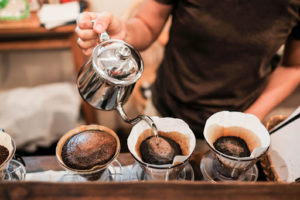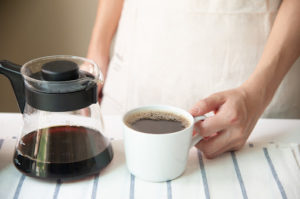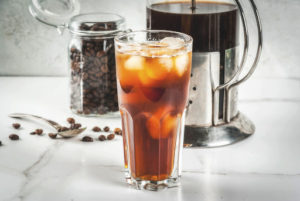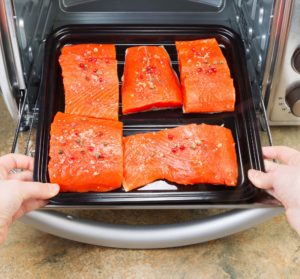
It used to be that a convection oven was seen as a fancy appliance that only lucky people owned. Now, more and more of us are able to appreciate the versatility and efficiency that a good convection oven offers. To be frank, most of us now consider a convection oven a necessity, not a luxury.
It’s funny, though–many of our kitchen appliances, such as ovens, toaster ovens, and microwaves, have a convection setting that goes unused–heck, most people don’t even realize that option is there in the first place.
Convection ovens can be used to crisp up pizza, roast meats, and bake desserts, and that’s just for a start. They offer faster and more even cooking by using a fan that circulates heat throughout the oven space, with the result that there are no “hot spots” in your oven to ruin your cooking.
You might be wondering if–or, better yet, why–you need a convection oven if you already have a perfectly good traditional one in your kitchen. We’ll teach you the difference between the two and lay out for you the advantages of a convection oven.
Keep reading as we share the pros and cons of convection cooking and information about how to easily make adjustments for the recipes you make in a regular oven, as well.
Convection Oven v. Conventional Oven
Just by looking at them, you can’t tell the difference between a conventional and a convection oven. In fact, they are pretty much identical except for one important component: the additional fan system feature added to the convection oven.
Conventional ovens, also referred to as regular, traditional, radiant, or thermal ovens, have their heat source usually (but not always!) located at the bottom of the appliance. The heat is stationary, which means the surface closest to the heat source cooks the fastest.
In regular ovens, hot air rises and moves around the oven space at random. This creates hot and cool spots in the oven that result in burnt tops and undercooked bottoms of desserts and meats.
In contrast, convection ovens include a special fan that circulates air throughout the oven. This results in greatly minimizing the presence of hot and cool spots found in traditional ovens that are responsible for unevenly-cooked food.
There’s nothing really frightening or foreign about a convection oven: you can cook anything in a convection oven that you can cook in a conventional oven. It’s just that food cooked in a convection setting generally comes out tastier, crispier, and juicier.
You’ll be surprised when you find out how much more meat your oven will yield from that original cut, as meat shrinks less when cooking in a convection oven. Chicken, in particular, renders fat and browns more quickly in a convection oven, ending up juicier and with crispier skin after roasting.
Benefits of Using a Convection Oven
Convection ovens provide more consistent cooking. You don’t have to worry about food not being cooked properly or whether to place your pan on the lower, middle, or upper racks of the oven. A convection oven will cook your food to perfection, no matter where it is placed inside.
Another major benefit of convection ovens is that they can reduce your overall cooking time by up to 25%. The cooking temperature, by the way, is also reduced 25%, saving you time and money due to their increased efficiency.
The fan and exhaust system can also reduce the amount of needed humidity escaping the oven, making food juicier on the inside, but crisp and brown on the outside, just as we love it.
Other benefits of using a convection oven include:
- You don’t need to turn the dish or pan halfway through cook time
- Fast circulation of air accelerates baking and roasting
- Preheating is quicker
- It’s easier to cook multiple dishes at once using multiple racks in the oven
- They promote healthy eating because they’re a tasty alternative to frying
- Fewer parts mean less cleaning of the oven
- It allows thicker meat cuts to retain much of their juiciness during cooking
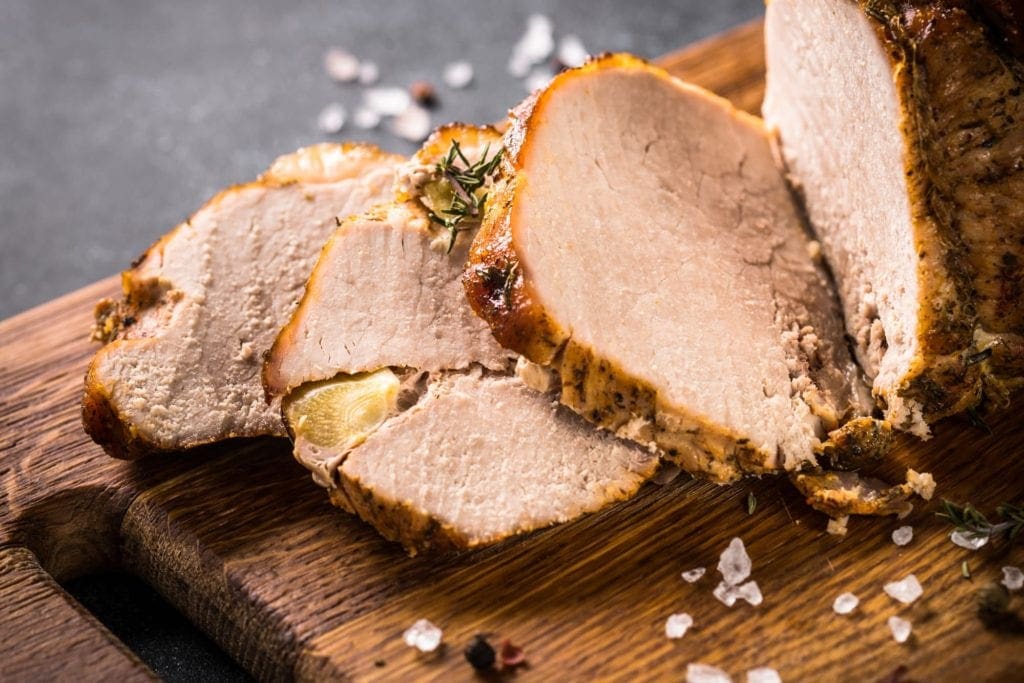
Why Use the Convection Setting?
Using the convection setting on the oven enables its built-in fan to circulate hot air around the food. The heat inside the oven is then evenly distributed as a result.
Due to steady heat and even air circulation, there are no hot spots in a convection oven. The food in it will cook more quickly and at a lower temperature than a regular one.
A convection oven’s exhaust system draws out the excess steam that makes the heat inside the oven drier, creating an environment that is ideal for roasting and baking. When you’re cooking a roast in this type of oven, for example, the meat’s exterior will be perfectly browned while its interior remains tender.
Pies, pastries, and cookies can also be baked using the convection setting. Fats melt and steam is created more quickly when you’re cooking with it, helping dough to rise higher as it bakes. Convection ovens also allow multi-rack baking–without you needing to rotate the pans halfway through the cook time–to achieve the even cooking of several baked goods simultaneously.
Finally, use the convection setting to speed the drying process for foods like jerky, nuts, and fruits. You also can use it to uniformly toast anything.
When to Use the Convection Setting
You can get the most benefit from the convection setting when you’re roasting and baking. This means convection ovens work best when cooking meats, vegetables, casseroles, cookies, and pies.
When roasting meats such as chicken and turkey on the convection setting, you will get a crispy and perfect browning of the skin. The inside will stay juicy and tender–just right for Sunday or Thanksgiving dinner.
Baking cookies, pies, and pastries is faster, also, when you’re using the convection setting. If you need to bake a large number of sweets at once for the elementary school’s bake sale, you can fill up the oven with multiple trays and just leave them to cook. You don’t even have to rotate them every so often to achieve even baking.
You can also use the convection setting in cooking pretty much anything that needs to be covered during cooking. This way, the dish will not lose as much moisture as it usually does.
You can also use the setting when you want to toast bread or dehydrate fruit slices. The convection setting will perform the dehydration process more efficiently than a conventional oven can.
When Not to Use the Convection Setting
Despite all the benefits you get from using the convection setting, it’s still not a perfect kitchen tool. Like any kitchen appliance, it can be the better choice for some recipes, while you’re better off using a conventional oven for others.
The convection setting won’t work well with food with a batter that needs to rise. Examples of these are cakes, custards, flans, soufflés, meringues, and quick breads. The air in convention cooking causes the end product of foods such as this to be lopsided.
Another weird result of using the convention setting on these types of foods is that their outsides may fully cook before their insides have even finished leavening. There will also be instances when convention cooking can simply just make baked goods much too dry.
How to Use the Convection Setting
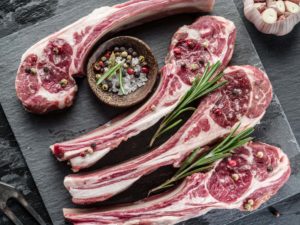
Once you decide to give the convention setting a try, there are a few things you should keep in mind.
You cannot just put the food inside the oven, turn on the convection setting, and expect your food to cook in half the time it typically takes.
It is precisely because food cooks quickly and more consistently in a convection oven that you need to make necessary adjustments from your regular oven settings.
- You need to adjust your favorite recipes to cook them in a convection oven. Most recipes were developed using traditional oven settings. Most professionals advise lowering the temperature by 25 degrees when you cook with a convection oven. There are some models that will automatically do the adjusting for you, since the whole process can be confusing for some.
- Check your food’s progress frequently, but even more often towards the end of the recipe’s cook time. Food cooks quickly under a convection setting and you want to make sure it’s not burning. But–do not open the oven door to check. Look through the oven’s front window, instead. Convection cooking relies heavily on the correct hot air circulation inside the oven. Heated air will escape, disrupting the convection process, if you open the oven door during cooking.
- Space your food out properly when cooking it in a convection oven. You need to give your food room to “breathe” so as not to hinder the convection process; hot air needs to circulate all around the food.
- Use low-sided pans in order to take full advantage of the convection setting benefits. Make sure that the sides of the pan will not keep the hot air from circulating correctly.
What to Look for When Buying a Convection Oven
You probably have a convection oven already and just don’t even know it! This is because the most common type is a conventional oven that has a built-in fan. It lets you turn the convection setting on and off.
True convection ovens have heating elements near the fan that, aside from warming the air, also maintain a more consistent temperature within the oven itself. This is what they often refer to as the “third element” or “European convection”. These terms are synonymous with “true convection.”
Size
The sizes of a convection oven range from full-sized wall ovens to small countertop ones. Experts advise that you choose the biggest convection oven you can afford, making sure first that it will fit in the space you intend to install it. This is because the bigger the space in which hot air can circulate freely, the more evenly the oven can cook the food.
Fan and Exhaust System
The fan helps hot air to circulate around the food while the exhaust pulls the heated air throughout the oven. True convection ovens have heating elements that efficiently regulate the temperature, allowing the convection process to reduce food’s cooking time to save energy, time, and money.
Settings
When buying a convection oven, look for an model with these four controls: bake, convection bake, convection roast, and broil. These are the most important settings you need to get the most out of your new appliance.
Extras
The more settings that a convection oven offers mean more accessories that will come with it, such as a fry basket, rotisserie fork, food trays, and cookbooks.
Although a convection oven with all the bells and whistles will be more expensive, remember: more accessories included with purchase means fewer items you will need to buy later on.
Conclusion
Convection ovens can either be gas or electric and they have fans that circulate air throughout the oven. Food will be cooked evenly because the presence of hot spots will be eliminated.
You will get the best results of the convection setting in roasting meats. Meats will be perfectly browned in the exterior while the inside remains tender.
Baked goodies like pies, flaky pastries, and cookies are better cooked in a convection oven also. The steam that is created will help the dough to rise more as they bake. However, a convection setting won’t work well with delicate baked goods like souffles, meringues, custards, and cakes.
Because food cooks quickly and more consistently in a convection oven, you need to make necessary adjustments in recipes once you decide to use it. Most recipes were developed using the traditional oven settings. You have to either lessen the cooking time by 25% or lower the temperature by 25 degrees.
Frequently Asked Questions
What is better convection or conventional oven?
Convection ovens allow more heat to transfer to speed up the cooking and at a lower temperature at that. Due to air circulating across the food, it is cooked evenly no matter where you place it in the oven, be it in the lower or higher rack.
The stationary heat in a conventional oven, on the other hand, cooks the food fastest on the surface closest to the heat source. That is why the usual problem of food becoming overcooked at the top happens.
All in all, the convection oven is better in terms of the quality of output and efficiency. It solves all the issues that the conventional oven has plus more!
What is the difference between convection and a regular oven?
The main difference between the two is in the heat distribution. The heat source of a regular oven is stationary, typically radiating from the bottom of the oven. A convection oven uses a fan to circulate air evenly inside the oven.
Convection ovens are able to provide for even and fast cooking because the temperature inside the oven is more consistent. On the other hand, conventional ovens can produce warm air pockets or cold spots.
The temperature is not consistent throughout especially since hot air always rises. So, if you use both top and bottom racks, the food on the top rack will likely have burnt parts on its top while that in the bottom rack will be undercooked. You will not have this problem with a convection oven.
When should you use a convection oven?
A convection oven should be used in roasting like meats and vegetables. They cook faster and more evenly. It produces crispy skin and better caramelization of the exterior due to the drier environment.
Pies and pastries also get more benefit with convection baking. The heat melts fat faster in the dairy ingredients. It also creates steam faster and this helps in giving pie doughs more lift.
Use the convection oven if you want to bake more than one tray of cookies. You can bake using multi-racks but achieving uniform results for your product. You don’t need to rotate the racks partway through baking as you would need to do in conventional cooking.
When you can put a cover over the food, like covering a casserole dish with foil,
cook it on convection so it will cook faster. This way, you will be able to minimize moisture loss on the food.
Speaking of moisture loss, you can turn this into an advantage when you want to toast or dehydrate food. Using a convection oven will perform the process more efficiently than a regular oven.
What does a convection oven do?
The convection oven fan’s main function is to allow air to circulate inside the oven and efficiently transferring heat into the food being cooked. Using it causes the food to brown faster and cook quickly without drying it out.
This is made possible by the fan being able to distribute heat more evenly than a traditional oven where heat is stagnant and isn’t consistent. Convection cooking avoids the creation of hot spots as well as being able to bake using multiple racks at one time.
When should you not use a convection oven?
Unfortunately, not all foods are suited for the convection cooking method. You will get lopsided results for delicate pastries like meringues and macarons. It might not be good to use a convection oven to bake cakes, soufflés, or scones since the circulating air in the oven may ruin them. They need a more steady atmosphere when being baked.
The fast-moving air will disrupt the baking of fragile dishes like soufflés. While a drier environment would be perfect for fried chicken and roast beef, it will not be the same for these baked goodies.
You must not use a convection oven that is overloaded. Doing so might get the fan blocked, rendering it useless. You must also make sure to reduce the temperature by around 25 degrees when using the convection setting. This is to prevent your food from not getting enough time to cook inside but already burning on the outside.
Do you preheat a convection oven?
There is no need to preheat a convection oven when cooking meat and poultry since they have a tendency to be overcooked. But, you can still do so if you want to. You can follow the user’s manual that comes with the convection oven or you can simply follow this method:
- Turn on the convection oven 10 to 15 minutes before you need to use it.
- Set the temperature as required by the recipe. Most convection ovens automatically make adjustments in temperature from the regular setting. If it does not, be sure to lower the temperature by 25 degrees.
- Wait for the oven to indicate when it has finished the preheat cycle.
Additional Resources
- WikiHow: How to Use the Convection Setting on an Oven
- Martha Stewart: How to Convert Your Recipes for a Convection Oven
